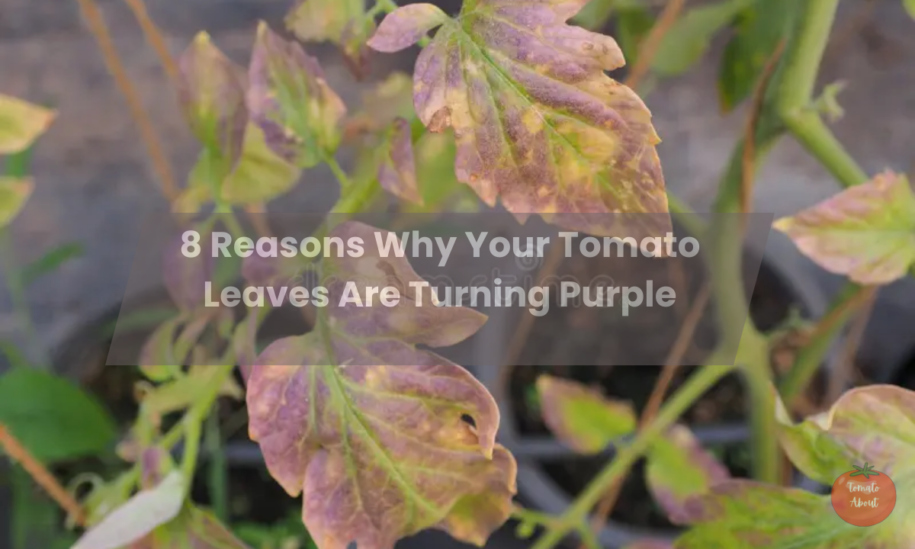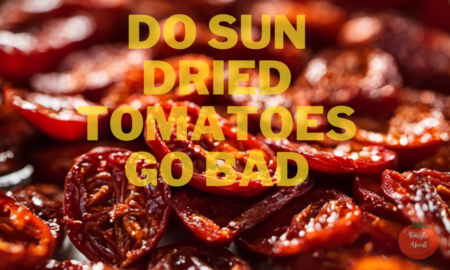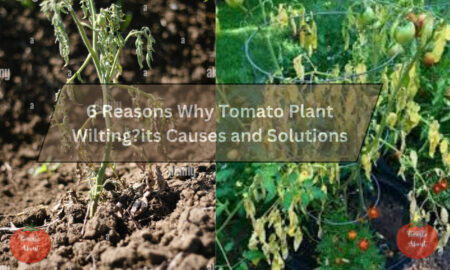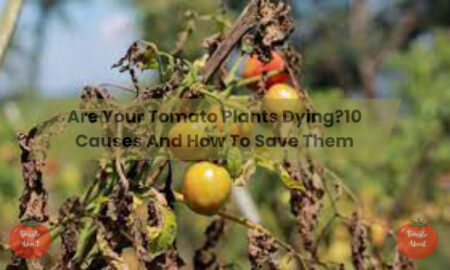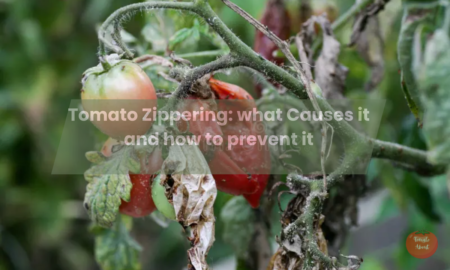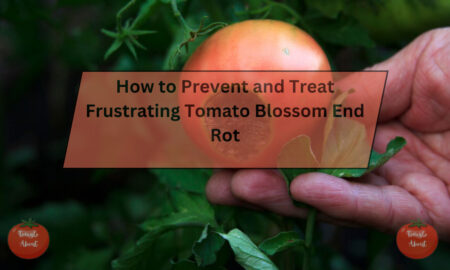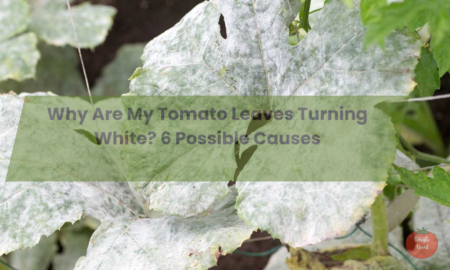Key Takeaways
- Some tomato varieties naturally have purple leaves due to anthocyanins, and it’s normal and harmless.
- Cold weather can cause purple leaves, and improving plant fertility can help them revert to green.
- Overripe tomatoes emit ethylene gas, turning nearby leaves purple, so harvest ripe fruits promptly.
- Phosphorus deficiency can lead to purple leaves, so test and amend your soil to restore nutrient levels.
- High soil alkalinity can induce phosphorus deficiency, so adjust soil pH gradually with elemental sulfur or ammonium sulfate
A healthy tomato plant is a beautiful sight – vibrant green leaves provide a canopy for ripening tomatoes. So when those leaves start turning another color, it’s cause for concern.
Purple leaves on tomato plants are not a rare occurrence, especially with certain varieties. But what causes this phenomenon? And what can you do about it?
In my experience growing tomatoes, I’ve dealt with my fair share of purple leaves. After researching the possible reasons, I’ve been able to diagnose and treat the causes when they’ve cropped up.
Here are the eight most likely reasons your tomato leaves are turning purple, along with solutions to get your plants back to their vibrant green.
So, Why do Tomato Leaves Turn Purple?
Tomato leaves can turn purple due to genetics, cold weather stress, overripe fruit, phosphorus deficiencies, high soil pH, herbicide exposure, plant diseases, and insufficient sunlight.
Let’s Discuss each reason in detail
1. Tomato Variety
Some tomato varieties are genetically prone to having purple-tinted leaves. Certain heirloom types like Black Krim and Cherokee Purple are most well known for their darker purple foliage.
The pigments that cause this natural coloring are anthocyanins. They tend to accumulate in the leaves of certain varieties, especially in the veins and undersides.
Since the anthocyanins are inherent to that tomato type, there’s not much you can do to prevent the purple coloration. But take heart – it’s completely normal and not harmful to the plant.
As long as the new upper growth continues looking healthy and green, you can enjoy growing your beautiful dark-leaved heirloom tomato. The purple tones make an attractive contrast to the ripening tomatoes!
To check if variety is the cause, look for purple only on the undersides and veins of older, lower leaves on the plant. The younger top leaves and new growth should still be vibrant green if the heirloom coloration is all that’s at play.
2. Cold Weather
Temperature fluctuations are another prime culprit for triggering tomato leaves to turn purple. Tomatoes thrive when daytime high temperatures are between 70-85°F.
When the nighttime lows drop under 55°F, it leads to stress on the plant. Chilly conditions cause an accumulation of sugars and anthocyanin pigments in the leaves. The purple color acts as a protective sunscreen to shield the leaves from cold shock and light damage.
If your tomato plants begin developing purple coloration during a cold snap or period of up and down temperatures, don’t panic. Boost the plant’s fertility to help it cope with the stress. The purple tint should fade back to green once the weather warms up again.
However, if your plants are still young seedlings, take preventative action by covering them overnight. Use row covers, hot caps, cloches, or other protection to shield plants from cold nights. Just remove the coverings during the warmest part of the day to avoid overheating.
Don’t over-prune purple leaves in this situation. The pigments are part of the tomato plant’s natural adaptive defenses against temperature fluctuations. As long as the top new growth continues looking healthy, the older leaves should regain normal color once the weather improves.
3. Overripe Tomatoes
An often overlooked cause of purple tomato leaves is overripe fruits still on the vine. Once tomatoes pass their peak of ripeness, they begin emitting high levels of ethylene gas. This hormone triggers anthocyanin production in surrounding plant tissues.
To avoid this, diligently monitor ripening fruits and harvest each tomato once it reaches its ideal color and full flavor. Overripe tomatoes will accelerate the purpling of the adjacent leaves via ethylene buildup. Prompt picking prevents excess gassing of nearby foliage.
The problem can be especially pronounced in indeterminate and heirloom varieties that ripen tomatoes simultaneously in clusters. For these plants, consider using ethylene-absorbing pads on the fruits. These pads help inhibit the release of ethylene, slowing leaf reactions.
Check for purple leaves only in the areas right around ripening fruits. If overripe tomatoes are the cause, their removal should allow that foliage to gradually regain normal green tones.
4. Phosphorus Deficiency
Phosphorus is an essential nutrient for healthy tomato foliage and plant growth. When phosphorus levels are low in the soil, it leads to clear deficiency symptoms.
You’ll notice the leaves taking on a reddish or purple discoloration beginning at the veins and margins. This coloration will spread eventually covering the entire leaf surface. The edges often curl or wrinkle as the deficiency progresses.
Have your soil tested to confirm a lack of phosphorus. Amendment with compost or a phosphorus-rich fertilizer like bone meal can help restore normal levels. For a quicker fix, foliar sprays made from fish emulsion or seaweed extract can provide a phosphorus boost.
Monitor the plants to see if the purple color diminishes as phosphorus becomes more available. However, leaves damaged by a severe deficiency may not fully recover. Their growth may remain stunted or distorted. But preventing new leaves from purpling is key.
5. High Soil Alkalinity
While phosphorus deficiency causes purple leaves, it’s often induced by high alkalinity in the soil. Tomatoes thrive best at a soil pH between 6.0-6.8. If pH creeps above 7.0 into alkaline territory, it limits the plant’s ability to take up phosphorus.
Use a soil pH tester to determine if this is the ultimate root of the issue. Applying elemental sulfur or ammonium sulfate will help lower soil pH a little at a time. Only make small adjustments every 2-3 weeks and retest. Getting pH into the optimal zone makes phosphorus available again.
It takes patience, but correcting high alkalinity can eliminate the induced phosphorus deficit that leads to characteristic purple leaf discoloration. Monitor new growth for signs of improvement as soil pH drops.
6. Herbicide Drift
Exposure to drifting herbicides like glyphosate (Roundup) is another potential cause of tomato leaves turning purple. These broad-spectrum herbicides are often used in nearby yards, gardens, and agricultural fields.
If spray droplets land on tomato plants, the herbicide is absorbed by the leaves. It blocks phosphorus uptake, essentially inducing a nutrient deficiency that leads to purple pigmentation.
If you suspect herbicide contamination, take quick action. Thoroughly wash plants with water to minimize further leaf absorption. Prune off any heavily damaged foliage, and discard unripe fruits, as the chemicals tend to accumulate in tissues.
Going forward, erect a physical barrier and talk to neighbors about spraying carefully on still days. Preventing drift is the only real solution, as herbicide damage can’t be reversed once done.
7. Diseases
While less common than other causes, certain plant diseases can also result in tomato leaves turning purple. These include fungal problems like early blight and Septoria leaf spot, and viral infections such as tomato mosaic virus.
You’ll notice patterns like yellow leaf spots turning purplish-black, dark veins, mottling, and uneven color distribution. Whole seedlings or sections of leaves can turn entirely purple or black from an advancing infection.
If disease is suspected, remove and destroy affected plants immediately to prevent spreading. Never compost diseased debris. To avoid future trouble, use resistant varieties, crop rotations, and regular fungicide sprays as prevention.
Early season treatment with chlorothalonil or copper fungicides can help limit foliar diseases. But these won’t cure an established infection once it takes hold. Vigilance and prompt removal are critical.
8. Insufficient Light
Finally, lighting conditions can also influence tomato leaves to turn purple. Varieties already high in anthocyanins show the most intense coloration when light levels drop too low.
If you notice purple leaves on indoor or heavily shaded plants, try gradually moving them into brighter sunlight. Just go slowly to prevent sun scalding on tender leaves unaccustomed to high light.
Acclimate tomatoes by increasing direct sun exposure over 7-10 days. Start with just 1-2 hours per day and work up to leaving them in full sun. Monitor color changes as light exposure increases.
Ensure adequate moisture and fertility as well. Dry-stressed plants are less able to adjust to changing light levels. With time and optimal care, the purple color caused by low light can be reversed.
What To Do for Purple Tomato Leaves
If you spot a purple color spreading on your tomato plant leaves, start by identifying the possible causes above. Consider recent weather, soil conditions, nearby plants, and signs of disease.
Review your care routine as well, thinking about recent fertilizing, pruning, and harvesting practices. Piecing together the clues will lead you to the most likely reason purple is developing.
Use the specific solutions outlined already to treat the underlying cause, be it cold, excess alkalinity, phosphorus deficiency, disease, or another factor. Continued monitoring and quick action are key for rescuing your tomatoes.
With the right diagnosis and treatment plan, you can get tomato foliage back to that lush green color. Then sit back and enjoy the bumper crop of tasty tomatoes to come!
Frequently Asked Questions
Q: How can I use Epsom salts to treat purple tomato leaves?
A: Dissolve 1-2 tablespoons of Epsom salts per gallon of water and spray onto foliage. The magnesium in Epsom salts helps correct the purple color caused by magnesium deficiencies
Q: Will purple tomato leaves affect fruit production?
A: Purple foliage alone won’t directly harm tomato fruit development. However, underlying causes like cold weather stress, diseases, or nutrient deficiencies can reduce yields if not corrected.
Q: Should I remove purple leaves from my tomato plants?
A: Prune off severely damaged or dead leaves. But leave borderline purple leaves intact, as they can still photosynthesize. The plant will eventually drop them once new growth comes in.
Wrapping up!
In conclusion, purple leaves on your tomato plants may seem alarming at first but are often easily corrected through the diagnosis of the underlying issue, whether that is cold weather, low phosphorus levels, viral infection, or another problem.
Pay attention to patterns of symptoms, use organic solutions like compost and sulfur to amend soil conditions, remove diseased plants promptly, and adjust environmental factors like sunlight. With quick action to treat the cause, you can get your tomato foliage back to normal vibrant green and ensure a healthy, productive crop.

